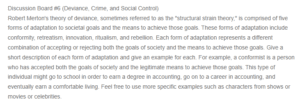Robert MertonsTheory-Deviance Crime and Social Control
The Structural Strain Theory evolved from Merton’s macro-level theory. It suggests that the cause of crime is brought up by the blocked access to gain success or a desired goal (Burton and Cullen). Adaptation is how an individual or a social group reacts or adjusts to their environment as favorable to their existence. The forms of adaptations within the theory include conformity, retreatism, innovation, ritualism, and rebellion.
Conformity involves pursuing cultural goals through socially approved means, and most people tend to be conformists. By this, it means that people believe they can only achieve the socially set success by going through the procedures viewed as right. For instance, a high school student can participate in bullying to get famous because the rest of the students find it right that bullies own the school corridors.
Retreatism involves escaping socially approved goals as well as the means to obtain them. Retreats do not embrace the social ideas of getting money, going to school, or having jobs. An example is people dropping out of school and surviving in ways like stealing. Innovation accepts and embraces society-set goals but not the means to achieve them. Innovators want success but not necessarily using specific socially approved means, an example being how a majority of drug dealers end up successful but not through ways the community would approve.
Ritualism is when someone does not believe in cultural goals but still goes through the processes to attain these goals. For instance, a ritualist can go to school and get a degree and a job but won’t really care about money or promotions, as money is not everything to them. Rebellion is when someone rejects both the goals and methods used and replaces them with culturally unacceptable ones. An example is how teenagers become rebellious, negative, and have hatred (Stinchombe and Aurthur). In conclusion, all these adaptation forms have their own rules, and everyone all over the world has a form they strongly believe in and practice.
Works Cited
Burton, Velmer S., and Francis T. Cullen. “The Empirical Status of Strain Theory.” Journal of Crime and Justice, vol. 15, no. 2, 1992, pp. 1–30., doi:10.1080/0735648x.1992.9721462.
Stinchcombe, Arthur L. “Rebellion in a high school.” (1964).
ORDER A PLAGIARISM-FREE PAPER HERE
We’ll write everything from scratch
Question
Discussion Board #6 (Deviance, Crime, and Social Control)
Robert Merton’s theory of deviance, sometimes referred to as the “structural strain theory,” is comprised of five forms of adaptation to societal goals and the means to achieve those goals. These forms of adaptation include conformity, retreatism, innovation, ritualism, and rebellion.

Robert MertonsTheory-Deviance Crime and Social Control
Each form of adaptation represents a different combination of accepting or rejecting both the goals of society and the means to achieve those goals. Give a short description of each form of adaptation and give an example for each. For example, a conformist is a person who has accepted both the goals of society and the legitimate means to achieve those goals. This type of individual might go to school in order to earn a degree in accounting, go on to a career in accounting, and eventually earn a comfortable living. Feel free to use more specific examples such as characters from shows or movies or celebrities.
Your first post should be a minimum of 250 words

